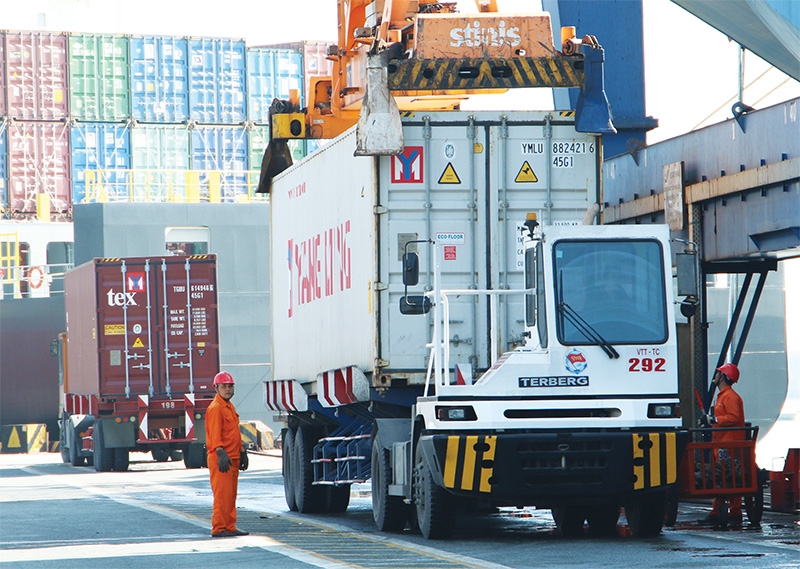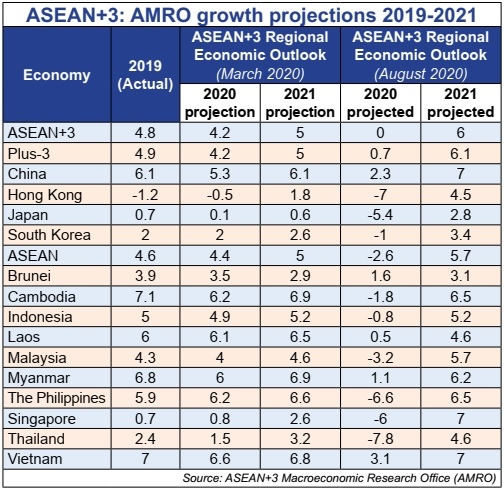Vietnam retaining fast-growing status
 |
| The World Bank’s projections indicate that Vietnam could be the fifth-fastest growing economy in 2020. Photo: Le Toan |
Spending a few hours walking around in Hanoi or Ho Chi Minh City, or any other locality in Vietnam, one cannot help but notice the immense energy and vitality. All streets and corners are bustling with dynamism featured by scooters and cars. People are using smartphones, one of the symbols of Industry 4.0 sweeping through the entire nation. Compared to just a couple of decades ago, Vietnam is now young, growing, and anything feels possible.
Before the Southeast Asian nation was opened to the wider world, Vietnam was one of the poorest in the world. By the mid-1980s, per capita GDP was stuck between $200 and $300. But in 1986, the government introduced the hallmark doi moi featured by a series of economic and political reforms, steering the country to becoming a socialist-oriented market economy.
“Vietnam, after two decades of rapid economic growth, is today considered a development success story. Political and economic reforms have transformed Vietnam from one of the poorest nations in the world to a middle-income country within a quarter of a century,” states the United Nations Development Programme in its introduction about the country on its website.
Currently, Vietnam is one of the stars of the emerging markets universe. Last year, the country’s GDP was $266 billion, representing a GDP per capita of $2,800, the highest in history. Its total export-import turnover reached $517.26 billion, up $36.7 billion against 2018. The export turnover hit $264.2 billion, up 8.4 per cent on-year, and the import turnover was $253.07 billion, up 6.8 per cent on-year.
Many global groups have set their firm niches in the ASEAN nation, including Samsung, Intel, Honda, Toyota, LG, GE, Cargill, Unilever, and Panasonic. Vietnam has also developed a large number of domestic private groups such as Vingroup, Hoa Phat, TH, Techcombank, VPBank, THACO, and Masan.
Peter Vanham, head of Communications at the Chairman’s Office under the World Economic Forum, cited analysts from the World Bank and the United States think tank Brookings Institution as stating that Vietnam’s economic rise can be explained by many factors such as efforts of the government in reforming the domestic business and investment climate, and trade liberalisation.
 |
Expanding trade
Vietnam has step-by-step expanded its relations with many nations. It has also actively and responsibly partaken in international forums and organisations.
Especially over recent years, the country has successfully negotiated and inked many free trade agreements (FTAs). To date, Vietnam has joined 16 FTAs comprising of seven as a member of ASEAN; five FTAs signed bilaterally with Chile, Japan, South Korea, the Eurasian Economic Union, and the EU (EVFTA); one as a member of the Comprehensive and Progressive Agreement for Trans-Pacific Partnership (CPTPP); and three others currently under negotiations – the Regional Comprehensive Economic Partnership, an FTA with the European Free Trade Association, and one with Israel. Moreover, Vietnam is also preparing for negotiations of an FTA with the United Kingdom.
Vietnam has also joined many high-profile forums and organisations such as the World Trade Organization and the Asia-Pacific Economic Cooperation. Currently, it is acting as ASEAN chair and is a non-permanent member of the UN Security Council.
“Its participation in FTAs and international organisations has given Vietnam both opportunities and challenges. Together with the roadmap in implementing its commitments in opening the Vietnamese market wider, the economy’s sectors/activities, including the attraction of foreign direct investment (FDI), have been directly and indirectly impacted by FTAs,” Lam Thi Quynh Anh, head of Division under the Office of the Inter-agency Steering Committee for International Economic Integration, told VIR.
According to Anh, FTAs contribute to further increasing trade relations between Vietnam and partners via the removal of trade barriers, which facilitates the attraction of FDI from the partners. With 13 FTAs that have come into force and three others currently under negotiations, Vietnam will have FTA-based relations with nearly 100 partners in the world.
“The deals have helped Vietnam strengthen its trade cooperation with many nations, accordingly prompting foreign investors to pay more attention to the Vietnamese market,” Anh said. “This has opened up big opportunities in investment and business cooperation between Vietnam and foreign investors.”
Statistics from the Ministry of Planning and Investment show that as of August 20, there were 137 nations and territories investing in Vietnam, with total registered capital of $381.16 billion. The leading investment partners are also key trade partners in FTAs that have already taken effect, including South Korea ($70.15 billion), Japan ($60.25 billion), and Singapore ($55 billion).
According to Anh, though commitments in FTAs are largely focused on opening markets for goods via tariff reduction and removal, there are also provisions directly relevant to the opening of the service and investment market and to policies for foreign investors. “This is clearly featured in FTAs having been negotiated and inked since 2012, especially new-generation FTAs like the CPTPP and the EVFTA,” she said.
Best performer
Since early this year the whole world has been hit seriously by COVID-19, causing disruption in supply and production chains. Given its deep integration with the global economy, Vietnam has been hit hard by the pandemic. Yet, the health impact of the outbreak has not been as severe in Vietnam as in other countries due to proactive measures at the national and subnational levels.
According to analysis from Singapore-based ASEAN+3 Macroeconomic Research Office (AMRO), which covers the ASEAN partners of China, Japan, and South Korea, Vietnam is forecast to have the highest growth rate this year and next year, at 3.1 and 7 per cent, respectively, in the region (see box), thanks to the nation’s effective anti-virus measures and favourable structural economy, as well as skilful macro-monitoring from the government.
Furthermore, despite a serious decline in local production caused by the pandemic, Vietnam is also projected by the World Bank to be one of the fastest-growing nations worldwide in 2020, with the economy forecast to stay among a few nations with positive growth globally.
According to the World Bank, assuming a gradual improvement in the world economy expected to decline by -5.2 per cent this year, Vietnam’s GDP should rebound in the second half of 2020 so that the economy will grow around 2.8 per cent for the entire year. It should further expand by 6.8 per cent in 2021 (baseline scenario). With less favourable external conditions, the economy will expand by only 1.5 per cent in 2020 and 4.5 per cent in 2021 (downside scenario).
“Regardless of scenario, Vietnam is expected to remain one of the fastest-growing economies in the world in 2020. This projected performance means that Vietnam would be the fifth-fastest growing country in the world in 2020,” said Stefanie Stallmeister, acting country director of the World Bank in Vietnam.
The bank explained that COVID-19 is a health shock that has forced governments around the world to make hard choices between saving lives and economic restrictions. While many countries hesitated in their decision process, Vietnam reacted quickly and boldly. The combination of early measures – targeted testing and tracking as well as innovative information campaigns – has proved to be highly effective.
Also citing the same reason, global data analysts and provider FocusEconomics told VIR in a statement that despite numerous difficulties caused by disrupted production chains due to COVID-19, Vietnam should still be by far the strongest performer in ASEAN thanks in part to a rapid resumption of domestic activity, as well as the effective health response allowed the swift lifting of restrictions from late April. FocusEconomics panellists project the economy will expand 2.7 per cent in 2020, and 7.5 per cent in 2021.
What the stars mean:
★ Poor ★ ★ Promising ★★★ Good ★★★★ Very good ★★★★★ Exceptional
Themes: Safe and Sound Vietnam
Related Contents
Latest News
More News
- PM orders investment model for North–South high-speed rail (December 22, 2025 | 17:43)
- First members of Danang International Finance Centre revealed (December 22, 2025 | 17:39)
- Securing capital and efficiency for Vietnam’s 2026-2030 growth ambitions (December 17, 2025 | 10:00)
- Driving double-digit growth through green and circular transformation in Vietnam (December 17, 2025 | 09:00)
- Vietnam bucking trend in the global M&A landscape (December 16, 2025 | 14:20)
- Vietnam’s green transition demands collective financial action (December 15, 2025 | 12:00)
- VIR workshop highlights capital and policy for sustainable development (December 15, 2025 | 11:00)
- National Assembly approves pilot mechanisms to accelerate major projects in Hanoi (December 12, 2025 | 11:29)
- Vietnam eases policy approval requirements, simplifies foreign and outbound investments (December 11, 2025 | 17:53)
- Unpacking new momentum in Vietnam’s M&A market (December 10, 2025 | 09:59)

 Tag:
Tag:




















 Mobile Version
Mobile Version